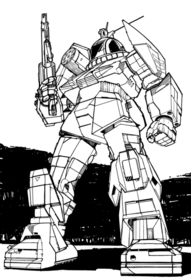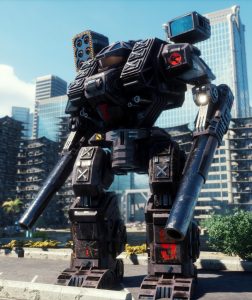Difference between revisions of "Super Griffin"
m (→Design: clarifications) |
|||
| Line 33: | Line 33: | ||
While its overall weight was increased to 60 tons, necessitating a slightly heavier internal structure, the ''Super Griffin'' retains the original CoreTek 275 [[fusion engine]] which could only provide a reduced ground speed of 64.8 km/h for the heavier frame. To make up for this, the 'Mech mounts 9 special [[Jump Jet]]s, giving it an unpredecented jump range of 270 meters. The armor was increased by half a ton and a [[Medium Laser]] was added on the left arm. Also, the ''Super Griffin'' mounts thirteen [[heat sink]]s, three of which are experimental [[Double heat sink#Double-strength heat sinks|double-strength heat sinks]], for a total heat dissipation capacity of 16 per turn, as opposed to the twelve regular heat sinks on the standard ''Griffin''. | While its overall weight was increased to 60 tons, necessitating a slightly heavier internal structure, the ''Super Griffin'' retains the original CoreTek 275 [[fusion engine]] which could only provide a reduced ground speed of 64.8 km/h for the heavier frame. To make up for this, the 'Mech mounts 9 special [[Jump Jet]]s, giving it an unpredecented jump range of 270 meters. The armor was increased by half a ton and a [[Medium Laser]] was added on the left arm. Also, the ''Super Griffin'' mounts thirteen [[heat sink]]s, three of which are experimental [[Double heat sink#Double-strength heat sinks|double-strength heat sinks]], for a total heat dissipation capacity of 16 per turn, as opposed to the twelve regular heat sinks on the standard ''Griffin''. | ||
| − | It should be noted that the ''Super Griffin'' as described in the sourcebook is an illegal design and cannot be built under | + | It should be noted that the ''Super Griffin'' as described in the sourcebook is an illegal design and cannot be built under current rules: |
===Jump jets=== | ===Jump jets=== | ||
| − | According to the construction rules, the number of jump jets is limited to the walking movement points. A 60-ton 'Mech with a class 275 fusion engine like the ''Super Griffin'' would therefore only be allowed to mount four jump jets which would weigh one ton each. (It is technically legal to mount a mismatched fusion engine but the performance is rounded down, in this case to equal a class 240 fusion engine.) | + | According to the construction rules, the number of jump jets is limited to the walking movement points. A 60-ton 'Mech with a class 275 fusion engine like the ''Super Griffin'' would therefore only be allowed to mount four jump jets which would weigh one ton each.<br>(It is technically legal to mount a mismatched fusion engine but the performance is rounded down, in this case to equal a class 240 fusion engine.) |
| − | The ''Super Griffin'', however, is said to mount nine jump jets | + | The ''Super Griffin'', however, is said to mount nine jump jets which together weigh 4.5 tons, i.e. half a ton each. No record sheet exists to indicate the location of the jump jets. |
| − | To remedy this rules violation it has been suggested to assume the ''Super Griffin'' has four jump jets of 1 ton each; however, this is not supported by canon sources and the reduced movement leaves the 'Mech somewhat hamstrung. | + | To remedy this rules violation it has been suggested to assume the ''Super Griffin'' has four jump jets of 1 ton each.; however, this is not supported by canon sources and the reduced movement leaves the 'Mech somewhat hamstrung. It would also leave the design half a ton underweight but that is technically legal. |
| − | ''It is noteworthy that the allocation of jump jets does in fact conform with the rules from the | + | ''It is noteworthy that the allocation of jump jets does in fact conform with the original construction rules from the ''[[BattleDroids]]'' game: These rules had no limit on the number of jump jets that could be mounted, and they were always half a ton in weight irrespective of the 'Mech's tonnage. ''[[Tales of the Black Widow Company]]'', which is the source for the ''Super Griffin'' and ''Super Wasp'', was the very first sourcebook published for the franchise and was presumably written using the first draft of the construction rules; when it was published, the game had already been renamed to ''[[BattleTech]]'' and the construction rules had also changed.'' |
===Mixing standard and double heat sinks=== | ===Mixing standard and double heat sinks=== | ||
| − | [[Double heat sink]]s cannot normally be mixed with standard heat sinks. However, special house rules regarding experimental double-strength heat sinks that could be substituted for and mixed with regular heat sinks were provided within | + | [[Double heat sink]]s cannot normally be mixed with standard heat sinks. However, special house rules regarding experimental double-strength heat sinks that could be substituted for and mixed with regular heat sinks were provided within Tales of the Black Widow Company, the sourcebook for that particular campaign. |
===Armor distribution=== | ===Armor distribution=== | ||
| − | The armor allocation of 22/7 to both torso sides is illegal. Even on a 60-ton frame the 'Mech may only mount altogether 28 points of armor on any side torso location. However, the ''Super Griffin'' has one less point of armor on both arms compared to the standard ''Griffin'' on which it is based, for no apparent reason. This suggests that the armor configuration given is in error, and that the | + | The ''Super Griffin'''s armor allocation of 22/7 to both torso sides is illegal. Even on a 60-ton frame the 'Mech may only mount altogether 28 points of armor on any side torso location. However, the ''Super Griffin'' has one less point of armor on both arms compared to the standard ''Griffin'' on which it is based, for no apparent reason. This suggests that the armor configuration given is in error, and that the extra armor point on the side torso locations belongs on the respective arm instead. |
==Variants== | ==Variants== | ||
Revision as of 10:36, 16 August 2009

| |
| Super Griffin | |
|---|---|
| Production information | |
| Manufacturer | none (prototype) |
| Model | GRF-2N |
| Class | Heavy |
| Technical specifications | |
| Mass | 60 tons |
| Chassis | custom (prototype) |
| Armor | unknown |
| Engine | Core Tek 275 |
| Speed | 64.8 km/h |
| Jump Jets | yes (manufacturer unknown) |
| Armament |
|
| BV (1.0) | ? |
| BV (2.0) | ? |
The GRF-2N Super Griffin is an evolution of the classic Griffin, a re-design that essentially produced a new BattleMech with even a different tonnage.
Contents
Armament
The Super Griffin retains the weapon configuration of the regular GRF-1N Griffin, namely a PPC in the right arm and a LRM-10 launcher with two tons of ammunition in the right torso. A Medium Laser was added to the left arm.
History
The Super Griffin was designed in "Project Phoenix" together with the Super Wasp at the Friden Aerospace Park research facility on Hoff by House Davion scientists including Dr. Jorge Belasco. After eighteen months of work, an operational Super Griffin prototype had been completed but it was still untested when the Black Widow Company attacked the facility on 13 May 3022. The prototypes were deployed as a last line of defense, and were presumably destroyed. There have been no recorded encounters with either design afterwards.
The Super Griffin and Super Wasp were described as the first fully-redesigned units in four decades, but the Hatchetman was hailed as the Inner Sphere's first new 'Mech design in over a century when it entered full production a few years after the attack on Hoff (and in the Periphery the Merlin had been designed in 3010 already). This suggests the Super Griffin and Super Wasp never came beyond the prototype stage.
Since both designs stretch the construction rules it can be assumed that the research results and blueprints were irrevocably lost over the course of the battles for Hoff; alternatively it can be speculated that their new technology turned out to be unreliable, or otherwise unsuitable for mass production for technical or economical reasons.
Design
While its overall weight was increased to 60 tons, necessitating a slightly heavier internal structure, the Super Griffin retains the original CoreTek 275 fusion engine which could only provide a reduced ground speed of 64.8 km/h for the heavier frame. To make up for this, the 'Mech mounts 9 special Jump Jets, giving it an unpredecented jump range of 270 meters. The armor was increased by half a ton and a Medium Laser was added on the left arm. Also, the Super Griffin mounts thirteen heat sinks, three of which are experimental double-strength heat sinks, for a total heat dissipation capacity of 16 per turn, as opposed to the twelve regular heat sinks on the standard Griffin.
It should be noted that the Super Griffin as described in the sourcebook is an illegal design and cannot be built under current rules:
Jump jets
According to the construction rules, the number of jump jets is limited to the walking movement points. A 60-ton 'Mech with a class 275 fusion engine like the Super Griffin would therefore only be allowed to mount four jump jets which would weigh one ton each.
(It is technically legal to mount a mismatched fusion engine but the performance is rounded down, in this case to equal a class 240 fusion engine.)
The Super Griffin, however, is said to mount nine jump jets which together weigh 4.5 tons, i.e. half a ton each. No record sheet exists to indicate the location of the jump jets.
To remedy this rules violation it has been suggested to assume the Super Griffin has four jump jets of 1 ton each.; however, this is not supported by canon sources and the reduced movement leaves the 'Mech somewhat hamstrung. It would also leave the design half a ton underweight but that is technically legal.
It is noteworthy that the allocation of jump jets does in fact conform with the original construction rules from the BattleDroids game: These rules had no limit on the number of jump jets that could be mounted, and they were always half a ton in weight irrespective of the 'Mech's tonnage. Tales of the Black Widow Company, which is the source for the Super Griffin and Super Wasp, was the very first sourcebook published for the franchise and was presumably written using the first draft of the construction rules; when it was published, the game had already been renamed to BattleTech and the construction rules had also changed.
Mixing standard and double heat sinks
Double heat sinks cannot normally be mixed with standard heat sinks. However, special house rules regarding experimental double-strength heat sinks that could be substituted for and mixed with regular heat sinks were provided within Tales of the Black Widow Company, the sourcebook for that particular campaign.
Armor distribution
The Super Griffin's armor allocation of 22/7 to both torso sides is illegal. Even on a 60-ton frame the 'Mech may only mount altogether 28 points of armor on any side torso location. However, the Super Griffin has one less point of armor on both arms compared to the standard Griffin on which it is based, for no apparent reason. This suggests that the armor configuration given is in error, and that the extra armor point on the side torso locations belongs on the respective arm instead.
Variants
None known. Although a functional prototype was built, the Super Griffin, itself a variant of the Griffin, apparently never advanced beyond the prototype stage.
References
- Tales of the Black Widow Company (p. 47)


